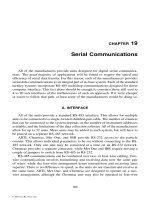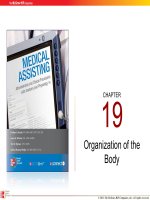Lecture Clinical procedures for medical assisting (4/e): Chapter 19 – Booth, Whicker, Wyman
Bạn đang xem bản rút gọn của tài liệu. Xem và tải ngay bản đầy đủ của tài liệu tại đây (1.47 MB, 51 trang )
������������������������������������������������������������������������������������������������������������������������������������������������������������������������������������������������������������������������������������������������������������������������������������������������������������������������������������������������������������������������������������������������������������������������������������������������������������������������������������������������������������������������������������������������������������������������������������������������������������������������������������������������������������������������������������������������������������������������������������������������������������������������������������������������������������������������������������������������������������������������������������������������������������������������������������������������������������������������������������������������������������������������������������������������������������������������������������������������������������������������������������������������������������������������������������������������������������������������������������������������������������������������������������������������������������������������������������������������������������������������������������������������������������������������������������������������������������������������������������������������������������������������������������������������������������������������������������������������������������������������������������������������������������������������������������������������������������������������������������������������������������������������������������������������������������������������������������������������������������������������������������������������������������������������������������������������������������������������������������������������������������������������������������������������������������������������������������������������������������������������������������������������������������������������������������������������������������������������������������������������������������������������������������������������������������������������������������������������������������������������������������������������������������������������������������������������������������������������������������������������������������������������������������������������������������������������������������������������������������������������������������������������������������������������������������������������������������������������������������������������������������������������������������������������������������������������������������������������������������������������������������������������������������������������������������������������������������������������������������������������������������������������������������������������������������������������������������������������������������������������������������������������������������������������������������������������������������������������������������������������������������������������������������������������������������������������������������������������������������������������������������������������������������������������������������������������������������������������������������������������������������������������������������������������������������������������������������������������������������������������������������������������������������������������������������������������������������������������������������������������������������������������������������������������������������������������������������������������������������������������������������������������������������������������������������������������������������������������������������������������������������������������������������������������������������������������������������������������������������������������������������������������������������������������������������������������������������������������������������������������������������������������������������������������������������������������������������������������������������������������������������������������������������������������������������������������������������������������������������������������������������������������������������������������������������������������������������������������������������������������������������������������������������������������������������������������������������������������������������������������������������������������������������������������������������������������������������������������������������������������������������������������������������������������������������������������������������������������������������������������������������������������������������������������������������������������������������������������������������������������������������������������������������������������������������������������������������������������������������������������������������������������������������������������������������������������������������������������������������������������������������������������������������������������������������������������������������������������������������������������������������������������������������������������������������������������������������������������������������������������������������������������������������������������������������������������������������������������������������������������������������������������������������������������������������������������������������������������������������������������������������������������������������������������������������������������������������������������������������������������������������������������������������������������������������������������������������������������������������������������������������������������������������������������������������������������������������������������������������������������������������������������������������������������������������������������������������������������������������������������������������������������������������������������������������������������������������������������������������������������������������������������������������������������������������������������������������������������������������������������������������������������������������������������������������������������������������������������������������������������������������������������������������������������������������������������������������������������������������������������������������������������������������������������������������������������������������������������������������������������������������������������������������������������������������������������������������������������������������������������������������������������������������������������������������������������������������������������������������������������������������������������������������������������������������������������������������������������������������������������������������������������������������������������������������������������������������������������������������������������������������������������������������������������������������������������������������������������������������������������������������������������������������������������������������������������������������������������������������������������������������������������������������������������������������������������������������������������������������������������������������������������������������������������������������������������������������������������������������������������������������������������������������������������������������������������������������������������������������������������������������������������������������������������������������������������������������������������������������������������������������������������������������������������������������������������������������������������������������������������������������������������������������������������������������������������������������������������������������������������������������������������������������������������������������������������������������������������������������������������������������������������������������������������������������������������������������������������������������������������������������������������������������������������������������������������������������������������������������������������������������������������������������������������������������������������������������������������������������������������������������������������������������������������������������������������������������������������������������������������������������������������������������������������������������������������������������������������������������������������������������������������������������������������������������������������������������������������������������������������������������������������������������������������������������������������������������������������������������������������������������������������������������������������������������������������������������������������������������������������������������������������������������������������������������������������������������������������������������������������������������������������������������������������������������������������������������������������������������������������������������������������������������������������������������������������������������������������������������������������������������������������������������������������������������������������������������������������������������������������������������������������������������������������������������������������������������������������������������������������������������������������������������������������������������������������������������������������������������������������������������������������������������������������������������������������������������������������������������������������������������������������������������������������������������������������������������������������������������������������������������������������������������������������������������������������������������������������������������������������������������������������������������������������������������������������������������������������������������������������������������������������������������������������������������������������������������������������������������������������������������������������������������������������������������������������������������������������������������������������������������������������������������������������������������������������������������������������������������������������������������������������������������������������������������������������������������������������������������������������������������������������������������������������������������������������������������������������������������������������������������������������������������������������������������������������������������������������������������������������������������������������������������������������������������������������������������������������������������������������������������������������������������������������������������������������������������������������������������������������������������������������������������������������������������������������������������������������������������������������������������������������������������������������������������������������������������������������������������������������������������������������������������������������������������������������������������������������������������������������������������������������������������������������������������������������������������������������������������������������������������������������������������������������������������������������������������������������������������������������������������������������������������������������������������������������������������������������������������������������������������������������������������������������������������������������������������������������������������������������������������������������������������������������ure
A Instructions to the pharmacist
___
C. Superscription
B Patient instructions
___
D. Inscription
© 2011 The McGraw-Hill Companies, Inc. All rights reserved.
1937
Vaccines
• Special preparations made
from microorganisms
• Administered to produce
reduced sensitivity to or
increased immunity to an
infectious disease
• Body creates antibodies in
response to an antigen
(vaccine)
© 2011 The McGraw-Hill Companies, Inc. All rights reserved.
1938
Antibody Formation
1. Antigen enters body
2. White cells produce antibodies
3. Antibodies combine with antigens
to neutralize them
4. This arrests or prevents reaction or disease
5. Vaccines stimulate antibody formation and
reduce symptoms if patient is exposed to
disease
© 2011 The McGraw-Hill Companies, Inc. All rights reserved.
1939
Immunizations
• Schedule for
immunizations for
children up to age 16
years
• Pre-exposure
immunizations
• Post-exposure
immunizations –
antiserum or antitoxin that
contains antibodies
© 2011 The McGraw-Hill Companies, Inc. All rights reserved.
1940
Immunizations (cont.)
• Medical assistant should be familiar with
– Indications
– Contraindications
– Dosages
– Administration routes
– Potential adverse effects
– Methods of storing and
handling
© 2011 The McGraw-Hill Companies, Inc. All rights reserved.
1941
Apply Your Knowledge
Why are vaccines given to patients?
ANSWER: Vaccines are administered to a person to
produce reduced sensitivity to or increase immunity to
an infectious disease.
© 2011 The McGraw-Hill Companies, Inc. All rights reserved.
1942
Patient Instruction on Medications
• Medical assistant role is important
• OTC drugs
– Should not be used to avoid medical care
– May not produce enough therapeutic benefit
– May be dangerous in combination with other
substances or drugs
– May mask symptoms or aggravate a problem
© 2011 The McGraw-Hill Companies, Inc. All rights reserved.
1943
Patient Instruction on Medications (cont.)
• Prescription drugs
– Inform patient about special
considerations and drug
safety precautions
– Encourage patient to
• Maintain a complete list
of medications
• Report adverse reactions
• Patient compliance
© 2011 The McGraw-Hill Companies, Inc. All rights reserved.
1944
Patient Instruction on Medications (cont.)
• To prevent medication errors, be sure
patient understands prescription
– How and when to take the medication
– Appropriate language
– Demonstrate if necessary
– Review warnings about
the medication
© 2011 The McGraw-Hill Companies, Inc. All rights reserved.
1945
Apply Your Knowledge
Mrs. Del Rosario tells you she does not take any
medication when you are taking her history. When you
question her further, she says she takes an OTC pain
medication occasionally and routinely take several herbal
supplements. What should you tell her?
ANSWER: You should tell her it is important to report all
medications, including OTC drugs and herbal and other
supplements, to the physician and that they may be
dangerous in combination with other substances or drugs
or may mask symptoms or aggravate a problem.
Nice Job!
© 2011 The McGraw-Hill Companies, Inc. All rights reserved.
1946
In Summary
19.1 The five categories of pharmacology include
pharmacognosy, pharmacokinetics,
pharmacodynamics, pharmacotherapeutics, and
toxicology.
19.2 The chemical name of a drug is based upon the
chemical makeup of the medication. The generic
name is the drug’s official name, and the trade name
is the name given a medication by the manufacturer.
A medical assistant should be familiar with both the
generic and trade names.
© 2011 The McGraw-Hill Companies, Inc. All rights reserved.
1947
In Summary (cont.)
19.3 Drug categories are sometimes named based upon
their action; for example, anticonvulsants are used to
treat convulsions (seizures). The major drug
categories and their actions are outlined in Table 192.
19.4 The main book sources for drug information are the
Physicians’ Desk Reference (PDR), Drug Evaluations,
United States Pharmacopeia/National Formulary, and
the American Hospital Formulary Service. You may
also access medication information from package
inserts, at the web site www.rxlist.com, or at other
reliable Internet sites.
© 2011 The McGraw-Hill Companies, Inc. All rights reserved.
1948
In Summary (cont.)
19.5 Nonprescription or over-the-counter drugs can be
obtained without a physician’s order. For prescription
drugs, patients must have a physician’s order.
19.6 For drugs that have been classified as controlled
substances because they are potentially dangerous
and addictive, extensive regulations apply. There are
five schedules (I to V) of controlled substances, with
schedule I being the most addictive.
© 2011 The McGraw-Hill Companies, Inc. All rights reserved.
1949
In Summary (cont.)
19.7 All physicians must be registered with the Drug
Enforcement Administration and follow the legal
requirements of the Controlled Substances Act of
1970 to administer, dispense, and prescribe controlled
drugs. The medical assistant must follow these legal
requirements when registering the physician.
19.8 Receiving and telephoning medication refills is
frequently done by the medical assistant for all
medications except schedule II and III drugs.
© 2011 The McGraw-Hill Companies, Inc. All rights reserved.
1950
In Summary (cont.)
19.9 Immunizations usually contain killed or weakened
organisms. When given, they stimulate the body to
build up a resistance to the organism. They are used
to provide immunity against specific diseases.
19.10 Patients should be educated about why, when, and
how they should take medications. This includes
instruction to ensure patient compliance regarding
nonprescription and prescription drugs, herbal
remedies, and supplements. Patients should also be
instructed about the dangers of medication
combinations, the importance of reporting an adverse
effect, and maintaining a complete medication list.
© 2011 The McGraw-Hill Companies, Inc. All rights reserved.
1951
End of Chapter 19
It is easy to get a thousand
prescriptions but hard to
get one single remedy.
~Chinese Proverb
© 2011 The McGraw-Hill Companies, Inc. All rights reserved.









